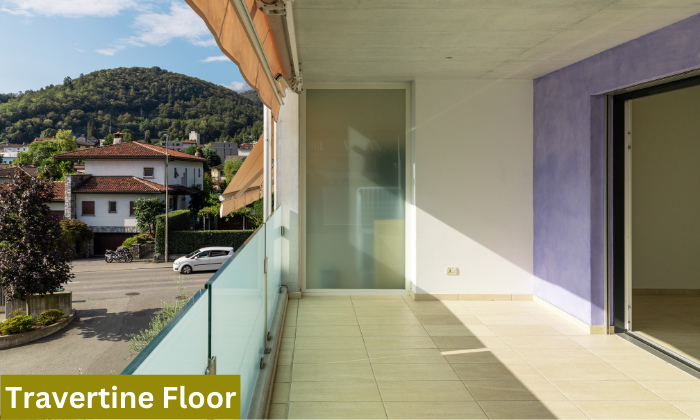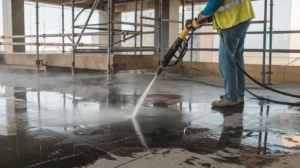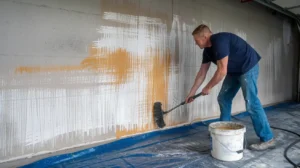How to Clean Travertine Floors: Travertine floors add elegance and sophistication to any space. However, without proper care and maintenance, they can become dull and stained over time. To ensure your travertine floors retain their natural beauty, it’s important to follow the right cleaning techniques and use the appropriate products.
In this comprehensive guide, Stone Sealer & Restoration shares their expertise on how to clean travertine floors effectively. From routine cleaning to addressing stubborn stains, we’ve got you covered.

What is Travertine?
Travertine is a type of sedimentary rock that is commonly used as a flooring material due to its unique beauty and durability. It is formed from limestone deposits and is characterized by its distinctive porous texture and natural color variations.
Benefits of Choosing Travertine Floors
- Elegant and timeless aesthetic appeal.
- Durability and long lifespan.
- Heat resistance, making it suitable for radiant floor heating systems.
- Can increase the value of your property.
- Versatility in design options.
Preparing for Cleaning
Gathering the Necessary Supplies
Before you begin cleaning your travertine floors, it’s essential to gather the following supplies:
- Soft-bristle broom or vacuum cleaner with a brush attachment
- Microfiber mop or soft mop
- pH-neutral travertine cleaner
- Distilled water
- Soft cloths or towels
- Stain removers (if needed)
- Stone sealer (for sealing the floor)
Clearing the Floor Area
To ensure efficient cleaning, remove any furniture or obstacles from the floor area. This will allow you to clean the entire surface without any hindrances.
Regular Cleaning Routine
Sweeping or Vacuuming
Start by sweeping or vacuuming the floor to remove loose dirt, dust, and debris. Use a soft-bristle broom or a vacuum cleaner with a brush attachment to prevent scratching the surface.
Mopping with a pH-Neutral Cleaner
Next, dampen a microfiber mop or soft mop with a solution of pH-neutral travertine cleaner and distilled water. Avoid using acidic or abrasive cleaners as they can damage the surface of the travertine. Mop the floor in gentle, overlapping strokes, ensuring thorough coverage.
Drying the Floor
After mopping, dry the floor using soft cloths or towels to prevent water spots or streaks. Ensure the floor is completely dry before allowing foot traffic or placing furniture back in the area.
Treating Stains and Spills
Identifying the Stain Type
Different types of stains require different treatments. Identify the stain type (e.g., oil-based, organic, or water-based) to choose the appropriate stain remover.
Applying a Suitable Stain Remover
Follow the manufacturer’s instructions and apply the appropriate stain remover to the affected area. Allow the stain remover to sit for the recommended duration to penetrate the stain.
Blotting and Rinsing
Using a soft cloth or towel, blot the stain gently to lift it from the surface. Rinse the area thoroughly with distilled water to remove any residue or cleaner.
Dealing with Heavy Stains or Grime Buildup
Using a Poultice for Deep Stains
For deep stains that are difficult to remove, consider using a poultice. A poultice is a paste made from a cleaning agent and an absorbent material. Apply the poultice to the stain, cover it with plastic wrap, and let it sit overnight. The poultice will draw out the stain from the travertine.
Performing a Deep Clean with a Stone Cleaner
If your travertine floors have significant grime buildup or stubborn stains, a deep clean with a specialized stone cleaner may be necessary. Follow the manufacturer’s instructions for the stone cleaner and use a soft mop or brush to clean the surface thoroughly.
Sealing the Floor for Long-Term Protection
To protect your travertine floors from stains and damage, it’s recommended to apply a stone sealer. A stone sealer creates a protective barrier that repels liquids and prevents absorption into the porous surface of the travertine.
Preventive Measures for Maintaining Travertine Floors
Placing Mats and Rugs
Strategically place mats or rugs in high-traffic areas and near entryways to minimize the amount of dirt and debris that reaches the travertine floors. Regularly clean and shake out the mats to prevent the buildup of dirt.
Using Felt Pads on Furniture
Attach felt pads to the bottom of furniture legs to prevent scratches and scuffs when moving or rearranging furniture on the travertine floor.
Regularly Dusting and Sweeping
Perform regular dusting and sweeping to remove loose dirt and debris from the floor. This will prevent them from scratching the surface during foot traffic.
Why We Choose Stone Sealer & Restoration
Stone Sealer & Restoration gives reliable ideas for your your problem about how to clean travertine floors and their maintenance needs. Here are a few reasons why you should choose us:
Expertise
With years of experience in the industry, Stone Sealer & Restoration has developed extensive knowledge and expertise in caring for travertine floors. Our team of professionals understands the intricacies of travertine and knows the best practices to ensure its longevity and beauty.
Trusted Products
We offer a range of high-quality products specifically designed for cleaning and maintaining travertine floors. Our products are formulated with the utmost care, using the finest ingredients that are safe and effective. When you choose Stone Sealer & Restoration, you can trust that you’re using products that are specifically tailored to your travertine floors’ needs.
Customized Solutions
We understand that every travertine floor is unique, and it requires personalized care. At Stone Sealer & Restoration, we provide customized solutions to address your specific concerns and requirements. Whether you’re dealing with stains, scratches, or general wear and tear, we can recommend the best approach to restore and maintain the beauty of your travertine floors.
Attention to Detail
We take pride in our meticulous approach to travertine floor care. From the selection of products to the execution of cleaning and restoration techniques, we pay attention to every detail. Our goal is to ensure that your travertine floors receive the best possible care, leaving them looking refreshed and rejuvenated.
Customer Satisfaction
Our priority is your satisfaction. We strive to deliver exceptional customer service, assisting you at every step of the process. We value your trust and work hard to exceed your expectations. When you choose Stone Sealer & Restoration, you can expect a seamless experience and outstanding results.
Make the right choice for your travertine floors by selecting Stone Sealer & Restoration. Experience the difference that expertise, quality products, customized solutions, attention to detail, and exceptional customer service can make. Trust us to keep your travertine floors looking their best. Stone also provide Marble stain removal and Marble scratch removal services.
Conclusion
Cleaning and maintaining travertine floors doesn’t have to be a daunting task. By following the expert tips and techniques shared in this guide, you can keep your travertine floors looking beautiful and prolong their lifespan.
Stone Sealer & Restoration’s range of high-quality products is designed specifically for travertine floors, ensuring optimal results and long-lasting protection.
Invest in the care of your travertine floors today and enjoy their timeless elegance for years to come. If you have any questions or need further assistance, feel free to contact us.
FAQs (Frequently Asked Questions)
Regular household cleaners often contain acidic or abrasive ingredients that can damage travertine floors. It is best to use pH-neutral cleaners specifically formulated for natural stone, such as Stone Sealer & Restoration’s Travertine Floor Cleaner.
Routine cleaning is recommended at least once a week to maintain the cleanliness and appearance of your travertine floors. However, high-traffic areas may require more frequent cleaning.
Vinegar is acidic and can etch the surface of travertine floors, causing damage over time. It is important to avoid using vinegar or any acidic substances when cleaning travertine.
Yes, it’s important to avoid dragging heavy furniture across travertine floors as it can scratch the surface. Additionally, placing doormats at entrances and using felt pads on furniture legs can help prevent scratches and protect your floors.
Using a steam mop on travertine floors is not recommended as the heat and moisture can penetrate the stone and cause damage. Stick to using a microfiber mop or a soft mop for routine cleaning.
Sealing your travertine floors is essential to protect them from stains and moisture damage. It is recommended to seal your floors every 1 to 2 years, depending on the level of foot traffic they receive.
Our Services
Our Latest Posts
How to Clean Concrete Floor | A Step-by-Step Guide for Sparkling Results
How to Clean Concrete Floor effectively is essential to maintaining its durability, visual appeal, and...
How to Remove Paint from Concrete
How to Remove Paint from Concrete can be a challenging task, especially when dealing with...
Top 7 Popular Quartz Countertops Colors in 2024
Quartz countertops colors are at the forefront of modern interior design, offering a perfect blend...





